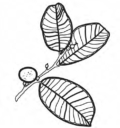..
.
Acquiring Mayanut Seeds
After discovering our project and the many virtues of Mayanut trees, people often approach us to obtain seeds. We thank them from the bottom of our hearts for their motivation to plant trees and their interest in our programme!
That said, however, we wish to emphasise that, like all other living beings, trees are adapted to particular ecosystems and climates, and have natural distribution areas. In their natural habitats, other species have also adapted to and formed relationships with them, securing their place within the complex web of life.
Taken outside their ecosystems, the introduced tree species may struggle to adjust and to survive, other organisms may fail to easily adapt to them, and as a worst-case scenario they can even negatively disrupt the natural equilibrium of their new setting.
For a more in-depth explanation of these potential disruptions, check out the Huffington Post article:
“Just Because it’ll Grow in your Yard Doesn’t Mean you Should Plant it”
The endemic region for MNT is Central America, Northern South America and the Caribbean arc. MNT cannot survive in regions outside the tropics and subtropics, except when grown in greenhouses or maintained as indoor ornamental plants. Furthermore, we certainly do not encourage the introduction of new species outside their natural distribution zones.
To think that we can improve an ecosystem by deciding what would be a “positive” addition, often indicates a lack of fundamental knowledge about the ecosystem. What can often seem like a benign action (planting a tree or two of an introduced species in your backward for example) has the potential to cause unforeseen and undesirable chain reactions over the longterm, such as the displacement of ecological niches. So please be diligent and do your research.
Instead of trying to plant MNT where it is not endemic, we encourage you to investigate other potential oxalogenous species that may be native to your region. While no definitively oxalogenous species have thus far been found in temperate climate zones, some initial studies have begun and there is certainly an opportunity for a lot more research in this regard!
Our Recommendations:
In Africa, Iroko (Milicia excelsa) is a species of oxalogenous tree most significantly studied by the University of Lausanne Faculty of Geosciences and the Environment. In Asia, Forest Commons has already planted in southern India several Tropical Dry Everygreen Forest oxalogenous species, including Diospyros ferrea (black ebony), Diospyros ebenum (Ceylon ebony), Diospyros melanoxylon (Coromandel/East Indian ebony), Diospyros montana (Bombay ebony).
In Central and Northern South America, MNT is the most important oxalogenous species to date and seeds can probably be found somewhere not far from you. Don’t hesitate to contact us if you are in this region and are having trouble finding seeds – we may be able to put you in touch with someone close by who has access to them! In addition to MNT, our research support to a Master’s student at the University of Lausanne has revealed the strong potential of other endemic species having oxalogenous qualities, including Ficus cotinifolia (alamo), Mangifera indica (mango), Tamarindus indica (tamarind), Gymnopodium floribundum (ts’iits’il che’), Cedrela odorata (Spanish cedar), Piscidia piscipula (Jamaican dogwood, or Jabin in Maya).
In addition to the species listed above, there are no doubt many other oxalogenous species that are still to be discovered. If you have a project in a particular area that you wish to discuss further, please feel free to reach out to us. We can also recommend directly contacting Eric Verrecchia’s laboratory of Geoscience at the University of Lausanne, which is conducting evolving research on oxalogenous trees around the world.
A Few Parting Thoughts:
The essence of biomimicry asks us to reconsider how we position ourselves relative to nature, and in particular to adopt a more humble posture where we accept that each ecosystem still has a lot to teach us. We hope you understand the need, therefore, to listen to the inherent wisdom of natural ecosystems, before seeking to modify them by introducing new species to non-native habitats.
Instead, why not visit your nearby forests, question the prevailing traditions and their guardians, talk to the wise men and women who know the local forest, and invest in meeting and better understanding the multifunctional trees that are already present in your region.
